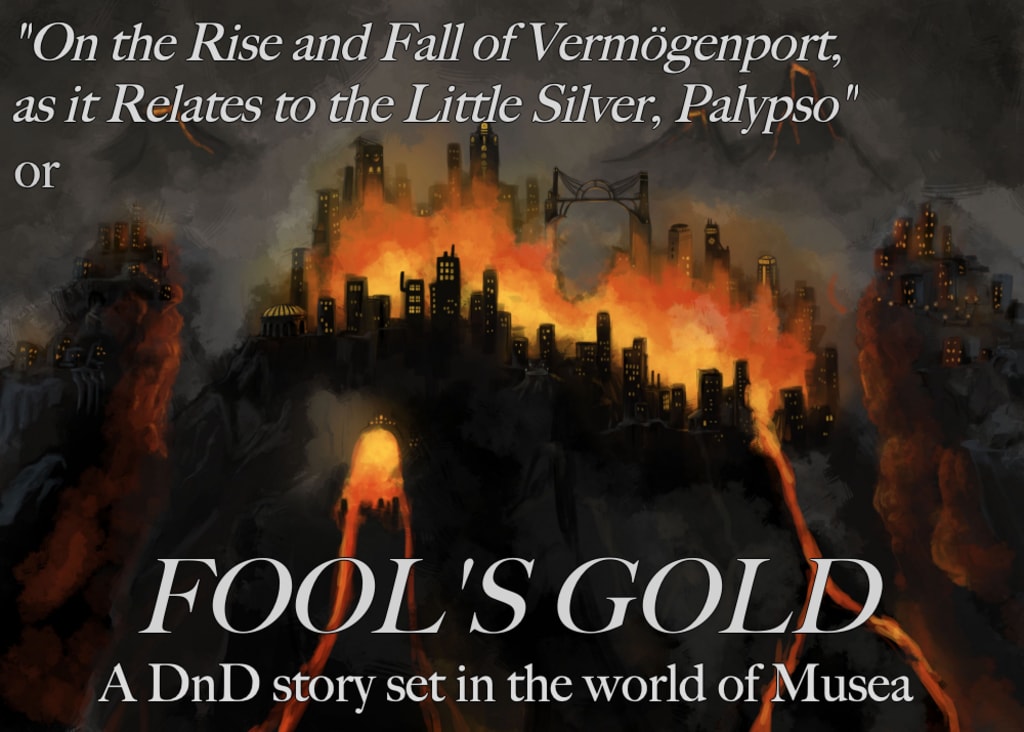Fool's Gold (Fable #2)
"On the Rise and Fall of Vermögenport, as it Relates to the Little Silver, Palypso": an in-universe fable about one of Musea's gods.

In any discussion of religious theory, particularly at the bar (everyone’s favorite debate hall), it is a mathematical certainty that someone will inevitably bring up the subject of human nature. Many atheists and theological skeptics regard this topic as the lynchpin that condemns all religion. The argument goes like this: the Gods, as described in the Tale of Musea’s Creation, are fallible. They are capable of mistakes. They possess faults. Therefore, they should not be worshiped, for their fallibility makes them just as mortal as anyone else.
Recently, following the Meeting at the Record, this argument was made ever-more complex. Mortals were made into Gods. But still, their fallibility remains. Is it better or worse that they were once human? Can we trust them more because they have actual human experience to reference—or can we trust them less, for the very same reason?
If one allows the barside debate to continue past this point, invariably, someone will mention Vermögenport.
Palypso’s first mistake, as some rather cruelly call it, started with a moment of all-too-mortal folly. It was but a few hundred years after her ascension. As the Tale goes, Palypso fell into mourning: the last of her mortal family had perished. One can hardly imagine the nature of such an experience; to be given godhood, but be unable to share its revelry with others.
In her mourning, Palypso grew neglectful. No longer did she wander to Miirikinix’s realm and dance along with the Music of the Spheres; no more was she interested in filling the Fey’s forest with false birdsong. It is said that even those few immortals she had befriended saw her no longer—the Necromancer philosopher, abandoned; the shaman with the changing face, left alone.
To continue this Tale, we must back up a little. You will forgive the shifting timestream of this servant of the Akasha.
Following the Meeting at the Record, great changes befell Musea. Cities rose and factions emerged in worship of these new gods. Morningstar was gifted Anvil’s Plunge by the Dwarves, eager to appease a God made of metal. The Hanging Gardens were discovered, and then tended, in Tliyel’s honor. And for Palypso, the humans made Vermögenport.
Vermögenport was, in its heyday, a bustling commerce. The clean, wide stone streets were plated with gold filament, and they had built an elaborate system of tunnels to keep waste out of the roads. These tunnels connected to the ocean, and flooded each dawn and dusk as the tide came in. Thus, the waste would be washed out to sea on the regular. In this way Vermögenport was kept effortlessly spotless.
All aspects of the city were a reflection of its goddess. In the center of the city was an enormous temple to Little Silver, fittingly decorated with (and clad in) silver. Surrounding this was an enormous bazaar of sorts, a concert hall for commerce. Believers in luck, fortune, and wealth often dwelled here. Beyond this were the homes of countless dance troupes and performers; beyond this, in the shadow of Vermögen’s walls, Palypso’s darkest followers lingered, deep in practice with the magic of the Shadow Plane.
Vermögenport grew into an enormous and well-loved place mere decades after its conception. There was no doubt in anyone’s mind that it would soon become a political powerhouse.
That is, until Palypso’s family died.
It should be noted that very little is known about Palypso’s mortal family. Indeed, little is known about the lives of any God who ascended during the Meeting at the Record. Efforts have been made to produce such information from city censures and public records, but mysteriously, there is no paper trail to be found. Perhaps Palypso’s domain of shadow has something to do with it.
At any rate, Palypso fell into a deep depression after the death of her final mortal loved one. Here she spun into a dark place of mourning and loneliness; the goddess of shadows could achieve feats of solitude far beyond the imagining of most mortals. As was said above, she simply disappeared. She no longer played her role.
Such decisions have consequences. It has been said:
“There is nothing more important to a God than their followers. Worship is the source of their strength; the very backbone of their power. Happy followers give a God everything they need: they pray often, they spread the word of their deity, they make homages and give offerings… in a pinch, they make for a dedicated army. But unhappy followers will turn on a God. Unhappy followers will make a God feel very, very powerless indeed.”
- Nomas Kavoran
No one was more neglected by Palypso’s post-mortem depression than her followers. It is said that the gold in the streets did not shine as brightly. Trader wagons broke frequently on the way to Vermögen, spilling precious merchandise into the sea below. The sun shone brightly in the sky above, so much that the shadows in the city waned to nothingness. Dancers tripped, broke ankles, cancelled long-awaited performances… the gamblers in particular had the worst of it. Not a drop of Palypso’s luck was left in Vermögenport.
Much writing was done about the city during this time. Naturally, many interpreted this bad fortune as an omen. Surely, ruin was to befall Vermögenport. Although this theory ultimately proved to be true, it is still worth looking at some of its fellows. One priest’s journal was recovered in the rubble:
“Today I woke in terrible spirits. The sun has been brighter than ever these past few weeks, yet I feel I am walking through a cold tomb of shadows. There is a pallor about me, and the city. Sleep cannot cure it. Sleep makes it worse. I am inconsolable, but there is no cause. I asked Tedalus if perhaps I had a prophecy inside of me; he had felt similarly before he delivered his sermon on the future of the trader fleet. But he told me he felt the same. Cold and dead inside. He told me everyone in Vermögen felt like this.”
- Author unknown, 892
This priest and many like him seemed to believe that this fugue state was par for the course. Perhaps it was indicative of a prophecy or a vision; perhaps an evangelical sighting or other religious event was about to take place. Even in misery, Little Silver’s followers sought their silver lining.
Furthermore, there was no concrete reason for anyone to believe that Vermögenport was in danger. The city’s popularity continued to rise, due to its advantageous location, remarkable cleanliness, and pleasantly cool weather. At this point in time, many of the travelers to Vermögen were not even religious folk—traders and businessmen had taken a natural liking to the city. These individuals, whose numbers were plentiful, were more than happy to dismiss the “bad omens” outright.
And so it came to pass that on the morning of Versalis 11, 893, the volcano above Vermögenport erupted.
Here we enter another evangelical tangle. Did Palypso deliberately cause the eruption, or is it all a coincidence? Many an author has commented on the subject:
“It was all Palypso’s doing. Haven’t you ever been depressed before? You just want to destroy everything. So that’s what she did.”
- Jonis Kivet’ta, Evangelist
“Obviously, this is a matter of nature. You can look back at the censure records when Vermögen was first being built. The advantageous position at the base of the mountains, right next to the sea—dozens of builders commented that it seemed ‘too good to be true.’ They were right. It was. This isn’t a religious aphorism; it’s a tragedy.”
- Inquisitor Declan Ceresina, of the Pathfinder Society
“Palypso… well, yes, she did do it. She’s a goddess, after all. But that doesn’t mean it was on purpose. Sadness is… rather a like a volcano. Constantly overflowing with molten pain. Is it really her fault that she couldn’t contain it?”
- Roseblood Osiria, Shaman
No matter the cause of the eruption, by the afternoon of Versalis 11, the better part of Vermögenport had been overrun with slag. In all, the tragedy was a mixture of negatives and positives. Positive: the mouth of the volcano was some several thousand feet up from Vermögen’s city walls, so the people had time to evacuate even as the eruption was happening. Negative: the terrain Vermögen was built along was at a slight slope, so there was plenty of reason for the lava to move quickly, and little reason for it to stop. Positive: the city militia was able to “wall in” the lava as it traveled, funneling it towards the ocean, and thereby destroying less of the city. Negative: the volcano itself was positioned at a steep incline, and it was not uncommon for gobs of magma to drop from the sky like hailstones, emulsifying citizens on contact.
It was several days before the city was even approachable again, let alone capable of sustaining life. Refugees stayed mostly in Northmanni, weeding through the trauma in inns and taverns. When the first expedition party was sent to observe Vermögenport’s remains, numerous travelers came along, bearing supplies and wagons. Many an artist’s rendition has been made of that long cavalcade of caravans, picking their way across the bluff above the northern ocean, cold wind whipping the soot of their destination into their faces.
The recovery of Vermögenport (or at least, what remained of it) has been documented in many places by many better-prepared scholars. Indeed, a paper is not necessary to understand Vermögen’s situation. It is evident by walking the city yourself.
Piles of hardened black magma, like so many anomalous hills, overrun and congest the streets at random intervals. Areas that have been cleaned away are nothing like the glory of their former selves; it is believed that the gold in the streets was melted to rivers by the fire. Of course, the worst damage is the collapse: the center of the city had caved in on itself from the heat and pressure, leaving a gaping, igneous-lined maw into the tunnels beneath the city.
And what of Palypso? What of her suffering?
Well, it should come as no surprise that her following has dropped significantly since the fall of Vermögenport. Palypso is nowhere near as loved—or discussed—as she once was. But, it seems, the goddess prefers it this way. She has made no attempt to bolster her public image with appearances, edicts, or miracles. Though the goddess has gone back to her old ways, evidently recovered from her mourning, she nevertheless seems perfectly content to remain in the shadows of Musea.
It is believed that what remains of her following is in agreement with their goddess. The temple to Palypso was destroyed in the eruption—but there are rumors that a new one has been built. Not a resplendent silver temple as before, but a hidden, private, reserved, discrete temple, built into the tunnels beneath the city.
Many times on pilgrimages, this servant of the Akasha has been asked to confirm or deny this rumor. To put the matter to rest, this can be said: in visiting Vermögenport, one can see clearly that despite the tortured city before them, there is an air of inescapable dignity to the place. A tortured grace. A calm, strident aura of power. This, I believe, to be the presence of the goddess Palypso. For her to be so present in Vermögen… well, surely a temple exists for her somewhere.
- The Unicorn, 1171
About the Creator
Olivia Fishwick
Olivia Fishwick is a freelance writer in Johnson City, Tennessee. She used to live in Arizona, but the desert was already weird enough without her getting involved. She uses Vocal to share stories and anecdotes from her DnD world, Musea.






Comments
There are no comments for this story
Be the first to respond and start the conversation.